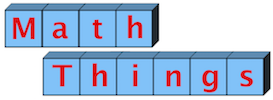Angles and Circles
Establishing the connection between circles & angles
When we first introduce angles, we can immediately draw the connection between angles and circles. This is a rich and interesting relationship, and because we are drawing circles and angles, and measuring them numerically at the same time, we can clearly see the relationship between the numbers and the drawings.
The following is taken from a presentation I gave in 2015, which is noted in more detail in my discussion of string and line designs.
1. The first regular shape visible to people before writing was a circle: the sun, perhaps?
2. There are 2 perspectives from which we see circles: from the outside, and from the center. Looking at the sun, we see a circle from the outside.
3. Then I say, “Imagine I'm the dot at the center of this circle. If I stand in place and turn completely around, my body and view have turned a circle with me at the center. Now I am looking at the circle from the inside. The circle outside of me is the horizon: the circumference.”
4. At this point, I turn completely around. I then ask all the students to get up and do the same. When I ask, “Who can describe what we just did?,” some students will always reply, “Turned around in a circle.”
5. Now let’s see what happens when we only turn part of a circle. I put my right hand straight out in front of me, pointing at the chalkboard. Then I make a quarter-turn to the right. I ask the students to do the same.
6. Then I draw the figure to the right on the board. “What 3 things do we see in this drawing that show what we just did?”
7. Some students will say, “Two lines.” And what do the two lines make together? “An angle.” That’s one thing: two lines (rays) intersecting form an angle..
Usually after a minute, someone will say, “A slice of pizza.” That’s two: an angle that forms a part of a circle with the vertex at the center.
Sometimes I have to prompt: “What forms the other edge of the slice of pizza?” It’s the arc…students may or may not have the word for it.
8. So right away we’ve established the connection between an angle, a part of a circle, and an arc.
9. To summarize:
a. We have 2 segments (rays) that intersect to form an angle. This is the textbook definition of an angle.
b. The rays cut out part of the circle (circumference) that the intersection is the center of. This part of the circle is an arc.
c. Together the angle and arc enclose a fraction of the circle.
d. Because angles cut out parts of circles, we use the same unit of measure to measure both angles, arcs, and circles.
10. Does anyone know what unit we use to measure angles/circles? In 4th grade, some students already know that angles and circles are measured in degrees.
11. How many degrees are in a full circle? Usually, someone will know this. Whether or not anyone knows, ask this: if we face north, turn to the right, and draw that angle, how many degrees will that angle have? Usually, some students know it’s a 90º angle, even if they don’t know what that means.
How many of these angles does it take to form a full circle?” Another way of asking this is, “What fraction of the circle is this?”
Start either with 360, or 90, and calculate the other measurement.
Either: 4 × 90= 360 or 360 ÷ 4 = 90
So students can derive the number of degrees in a full circle based on their acquaintance with a right, or 90º, angle.
12. Here are a couple of files you can use to introduce students to measuring angles.
The first is a protractor image which can be inserted into any document which is projected onto a Smartboard or other whiteboard. It's transparent, so text and drawings are visible through it.
The second is an introductory lesson to the use of the protractor, along with teaching notes.






